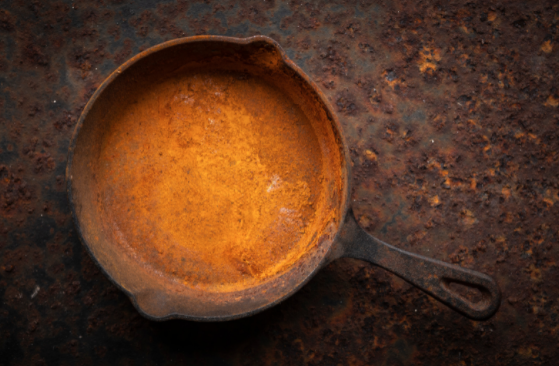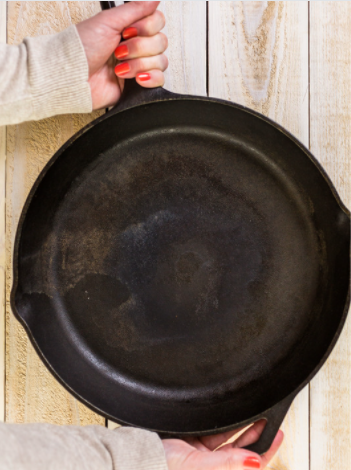How to Season a Rusty Cast Iron Skillet: The cast-iron skillet is one of the essential kitchen appliances that all households should have. Unlike stainless steel and aluminum cookware, cast iron provides a synthetic-free nonstick surface that requires less oil. It also keeps excellent heat retention so that you can cook recipes that need high temperatures, like caramelizing vegetables and searing steak.

If you’re consistently cooking with cast iron skillets and don’t clean them with soap, they will get better with age. In addition to using them, you have to provide them with proper care and maintenance. If you see your cast iron skillet is covered in rust, then you shouldn’t worry. Follow our step-by-step guide and help to return your skillet to its previous glory.
How to Clean a Rusty Cast Iron Skillet

Cleaning a cast-iron skillet includes many don’ts, such as you shouldn’t use dish soap and steel wool and put it in the dishwasher. It’s almost enough to ruin the seasoning of the cookware completely. Instead, follow these steps to keep your skillet rust-free and well-seasoned.
What You’ll Need
- One potato
- Vegetable oil or olive oil
- Coarse salt

The job you’re going to do might be a little bit messy, depending on the shape of your skillet. That’s why we recommend you go outside or cover your table with newspapers so that you can clean it easily.
The Steps:
1. Sprinkle a large amount of course salt into the skillet, depending on the pan you’re using. For example, if you use a 12-inch skillet, you’ll need about a half cup of salt or more as needed.
2. Cut the potato in half and place one-half of the potato on top of the salted skillet.
3. Start scrubbing around the pan in a circular motion. Put some pressure on the potato so that it can be moist enough and help the salt remove the rust.
4. Scrub all over your skillet: the edges, sides, handle, and bottom. After some time, you’ll see the salt is getting dirty. If you use a big-size skillet and need another round, rinse the dirty salt and begin with a new piece of potato. You have to continue the process from the beginning.
5. Once the cast-iron skillet is rust-free, wash thoroughly with water and let it be dry. You can put it on the stove at low heat for a minute so that any remaining moisture can disappear.
6. Next, coat the skillet with a small amount of vegetable or olive oil and rub the oil with a paper towel. Wipe any excess oil with a lint-free, clean cloth or with a clean paper towel.
7. Keep the skillet at low heat for half an hour. Once the estimated time is finished off, take it away from the stove and let it be cooled.
8. Once the cast-iron skillet has cooled, store it somewhere so that you can easily grab it in the future.
How to Season a Rusty Cast Iron Skillet
Keep in mind that warm skillet seasons are better. To season a rusty cast iron skillet, you have to do a pretty simple process, but it may take a little time.

To begin with, complete the cleaning process of the rusty skillet: wash the pan in soapy, warm water and then dry it with a soft towel. To make sure that the skillet is completely dry, put it in the oven at 200-degree Fahrenheit.
Now, it’s time to season it with some oil. You may use any oil, but organic flaxseed oil can provide the skillet with the hardest finish. So, you need to coat both the interior and exterior surfaces of the skillet with oil and wipe the excess oil with a soft cloth.
Place the pan in the middle of the oven rack. Then, turn the stove to the 450-degree Fahrenheit for 1 hour. If you want to have a beautiful heavy coat, repeat the process a few times, and the shiny skillet will last for years.
How to Care For Your Cast Iron Skillet

- While the pan is still warm immediately after you’ve finished cooking, wash it in fairly hot water and use a gentle scrubber, baking soda, or salt to remove leftover food.
- Avoid using dish soap or metal utensils to release stuck-on food. This will ruin the seasoning of your skillet.
- After you’ve cleaned the skillet, dry it completely in the oven or by hanging somewhere in the sunshine. Remember that you shouldn’t allow water to make rust into the pan.
- When you’re going to cook with the cookware, brush a little amount of oil all-around the interior surface and heat the skillet slowly to your desired temperature.
Conclusion
Having a cast-iron skillet in your kitchen is essential because it’s extremely durable, useful, and one of the great all-around kitchen appliances. You can use this heavyweight cookware in the oven or on top of the stove, or you can even use it over an open fire.
It’s an excellent option for one-pot cooking. You can brown the meat on top of the stove and then put it in the oven for making a roast. However, if you season it before each cooking, it will last for years without any major difficulties.
You may also like to read
- The 10 Best Carbon Steel Pan
- The 10 Best Jelly Roll Pan
- The 10 Best Ceramic Frying Pan
- The 10 Best Non Stick Copper Cookware
- Is Copper Cookware Safe?

Hello! I’m Paula Deen, a mother who loves to create memories in the kitchen. As a kitchen enthusiast, I love to do experiment with different kitchenware for daily recipes. This is my blog, where I’ll share my experience, knowledge, and reviews on various kitchenware and appliances.